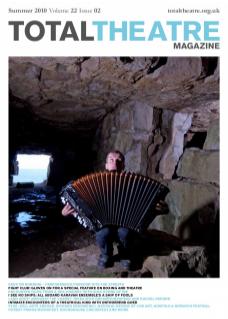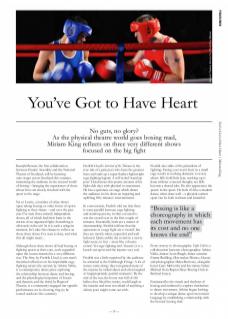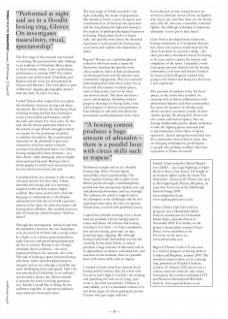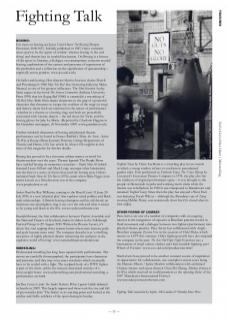Beautiful Burnout, the first collaboration between Frantic Assembly and the National Theatre of Scotland, will be bursting onto stages across Scotland this summer, immersing the audience in the visceral world of boxing – bringing the experiences of those whose lives are closely involved with the sport to the stage.
Yet as I write, a number of other shows open taking boxing or other forms of sports fighting as their theme – and over the past year I’ve seen three entirely independent shows, all of which had their basis in the notion of an organised fight. Something is obviously in the air! As it is such a zeitgeist moment, let’s take this chance to reflect on those three shows I’ve seen to date, and what this all might mean…
Although these three shows all had boxing or fighting sports at their core, each expanded upon the source material in a very different way. The first, by Fredrik Lloyd, is one man’s theatrical reflection on his improbable cage fighting career; the second, by Athina Vahla, is a contemporary dance piece exploring the relationship between dance and boxing, and the physiological responses of boxers and dancers; and the third, by Ragroof Theatre, is a community-engaged site-specific performance set in a boxing ring (to be toured outdoors this summer).
Fredrik Lloyd’s Survival of the Thinnest is the true tale of a pale poet who faces his greatest fears and ends up a super-feather-lightweight cage fighting legend. A self-styled ‘stand-up poet’ Lloyd mixes this poetic account of his fight club days with physical re-enactment. He has a quietness on stage which draws the audience in; his show an inspiring and uplifting fifty minutes’ entertainment.
In conversation, Fredrik told me that there is some parallel between cage fighting and stand-up poetry, in that you need to win the crowd over in the first couple of minutes. Essentially, both are a matter of showmanship. Fredrik told me that the spectators at a cage fight are a ‘crowd’, but they are mostly silent, respectful and well behaved. Quite unlike the crowd in a movie fight scene, in fact – more like a theatre crowd. Yet cage fighting isn’t ‘theatre’; it is a knock-out sport and the injuries very real.
Fredrik was a little surprised by the audience he attracted at the Edinburgh Fringe. A lot of nurses came along: they recognised many of the injuries he talked about and often laughed at ‘inappropriately painful moments’. By the end of the run, the house was full of old ladies; they liked the stories, could laugh at the injuries and were not afraid of anything a skinny poet might come out with.
Fredrik also talks of the primalism of fighting. Facing your worst fears in a small cage results in nothing domestic to worry about: bills hold little fear; washing-up is done without a second thought; tax bills become a shared joke. He also appreciates the poetic in the sport. He feels it’s like a modern dance, when done well – a physical contact sport can be both intimate and beautiful.
From oratory to choreography: Fight Club is a collaboration between choreographer Athina Vahla, dancer Leon Baugh, dance scientist Emma Redding, film-maker Monica Alcazar and photographer Helen Burrows, alongside boxer Gary McCarthy and his trainer father Michael from Repton Boys Boxing Club in Bethnal Green.
Fascinated by the rituals and rhythms of boxing and enthused to explore similarities to dance movement, Athina began looking to develop a unique dance-sport movement language by establishing a relationship with the historic boxing club.
The first stage of the research was focused on training. She presented her early findings to an audience at Chisenhale Dance Space in East London, where I saw a preliminary performance in autumn 2009. Five initial sessions were held at both Chisenhale and Repton and the work was documented by Alcazar and Burrows. This took place as part of Burrows’ ongoing photographic project with the club, No Guts, No Glory.
I asked Athina what inspired her to explore the similarities between boxing and dance movement. She told me she had always liked watching boxing and had been looking to create a new hybrid performance, which she calls sport theatre, for a few years. To this end, she has shown particular interest in the notion of agon (Greek: struggle/contest) as a means for the performer or athlete to redefine themselves. She is particularly interested in the threshold of pain and exhaustion and what makes someone continue beyond physical limits. For Athina, boxing encapsulates these elements – it is bare, direct, often damaging, and yet highly structured and focused. Boxing is like a choreography in which each movement has its cost and no one knows the end.
I wondered how, as a woman, it felt to enter a boxing club for the first time. Athina describes the boxing club as a hermetic, singular world without women, highly codified. She had to work hard to find the language to communicate to the Repton representatives that she even held a genuine interest in the sport, let alone that dance and boxing share affinities. She recalled, however, that Ali famously asked Foreman: ‘Shall we dance?’
Through her investigation, Athina found that the similarities between the two disciplines were the need for rhythm and a strong centre. In a fight, as in a dance, gestural precision, tight structure and painstaking preparation are key to success. Boxing is not, though, ultimately about aesthetics – the most important thing is the outcome, who wins. The task of locating a space between boxing and dance where each discipline keeps its integrity and yet an exchange is possible was more challenging than anticipated. Fight Club was presented at Chisenhale to an audience accustomed to dance, but Athina intends to present the work to boxing spectators too. ‘Ideally I would like to bring the two audiences together, so spectators/audience meet and learn from each other.’
The next stage of Vahla’s research is the fight, including the rituals of preparation. She intends to invite a team of experts and commentators to sit between the spectators and the ring during the fight and attempt a live analysis of physio-psychological functions in boxing. Future plans look to a larger scale, site-specific work where the theatrical experience is built around the boxing ring as an arena and explores the importance of space.
Ragroof Theatre are a multidisciplinary collective who have made a name for themselves creating site-specific work, often outdoors. Most of their productions are developed from real-life histories and community engagement. They are currently redeveloping their latest show Gloves On, to be toured this summer to urban spaces, such as skate parks, and on the street arts festival circuit. The show has been a year in development, including work-in-progress showings in boxing clubs. I met with company co-director and performer Ivan Fabrega to talk with him about the provenance and development of the show.
Performed at night and set in a floodlit boxing ring, Gloves On investigates masculinity, ritual, spectatorship. The show explores boxing and its place in the British psyche through a multidisciplinary production that incorporates spoken text, rap and physical performance (and yes, boxing!). The audience are asked to support either the champion or the challenger and the two opposing teams enjoy the show in separate fenced areas, covered with graffitied canvas.
I asked Ivan whether training to be a boxer held any parallels with his background in circus and dance. He told me that boxing training is very basic – no fancy equipment, just circuit training, press-ups, sit-ups, punching bags, skipping. But although boxing is physically demanding way beyond anything he has done before, a contest produces a huge amount of adrenalin, and in its dependence on fitness, calculated risk, and reactions in-the-moment, there is a parallel buzz with circus skills such as trapeze.
I wanted to know what Ivan enjoyed about boxing and he told me that, for a man who has never had a fight in ‘real life’, the training and ‘punching the shit out of a bag’, gave route to his inner masculinity. Violence is unavoidable, yet it’s a calculated violence: it is not about anger, it’s about getting the points. ‘A boxer who gets angry will lose.’
Ivan reflected on how certain boxers are revered as fantastic movers: there are fighters who slug it out, and then there are the artistic ones, like Ali, who was a beautiful, technical fighter. Yet although technique is important, ultimately ‘you’ve got to have heart’.
Gloves On has developed from within the boxing community so I wondered what the new street arts context would mean for the show. Ivan feels it’s a positive thing – the show provides a theatrical context for boxing to be seen, and to explore the history and complexity of the sport. I attended a workin-progress preview shared with the boxing community, ex-boxers and boxers’ families: for many of those Ragroof worked with, going to the theatre and being in a show was a new experience.
The question of audience is key for these pieces, as the artists have testified. In creating work in direct collaboration with professional fighters and their communities, they pose the question of whether such shows can have resonance outside of those specific groups. By taking their shows into arts venues and festival spaces, they are forcing traditionally passive theatre audiences to take the fighting sports seriously and to put themselves in the shoes of sports spectators. And in taking the work back into the communities from which it came, they are bringing contemporary performance to people who perhaps wouldn’t otherwise experience it. Points all round!
Fighting Talk
Boxing:
For more on boxing see Joyce Carol Oates’ On Boxing (Harper Perennial, 2006 NY). Initially published in 1987, Oates considers most sport to be the ‘game of combat’ whereas boxing ‘is the real thing’ and therein lays its morbid fascination. On Boxing is a history of the sport in America, a dialogue on contemporary concerns around boxing, explorations of the careers and personae of supernovas of the profession and a reflection on the significance of spectatorship – especially across genders. www.jco.usfca.edu
On ballet and boxing: film director Martin Scorsese claims Powell and Pressburger’s 1948 film The Red Shoes (featuring ballerina Moira Shearer) as one of his greatest influences. The film theorist Lesley Stern argues in her book The Scorsese Connection (Indiana University Press 1995) that his Raging Bull (1980) is essentially a reworking of The Red Shoes. Both films depict characters in the grip of a powerful obsession that threatens to escape the confines of the stage (or ring) and destroy them; both are interested in the nature of performance – whether in a theatre or a boxing ring; and both are powerfully concerned with totemic objects – the red shoes for Vicky and the boxing gloves for Jake La Motta. (Reported by Charlotte Higgins in the Guardian newspaper, 20 November 2009. www.guardian.co.uk)
Further scholarly discussion of boxing and physical theatre performance can be found in Franco Ruffini’s Mime, the Actor, Action: The Way of Boxing (Mime Journal; Pomona College Department of Theatre and Dance, US). See article by Alister O’Loughlin in this issue of this magazine for further details.
Boxing has proved to be a favourite subject matter or motif for theatre-makers over the years. Theatre legends The People Show have tackled boxing on numerous occasions – People Show 16 (which featured Laura Gilbert and Mark Long, amongst other luminaries) was the first in a series of shows that used the boxing icon. Others included People Show 66 The Boxer (1976), made when Mike Figgis (now better known as a film director) was in the company. www.peopleshow.co.uk
Sucker Punch by Roy Williams, coming to the Royal Court 11 June-24 July 2010, is a new ‘physical play’ that explores racial politics and black male relationships. A British boxing champion and his old friend, an American star prizefighter, slug it out over the title and what it meant to be young and black in the 80s. www.royalcourttheatre.com
Beautiful Burnout, the first collaboration between Frantic Assembly and the National Theatre of Scotland, makes its debut in the Edinburgh Festival Fringe 4–29 August 2010. Written by Bryony Lavery, it’s about ‘the soul sapping three minute bursts where men become gods and gods become mere men’. The company describe it as ‘a thrilling new piece of highly physical theatre immersing the audience in the explosive world of boxing’. www.nationaltheatrescotland.com
Wrestling:
Professional wrestling has long been equated with performance. The moves are carefully choreographed, the participants have characters and personae and they may even enact storylines which eventually have to be settled with a fight. The sculpted body of a WWF fighter is part of the show, unlike the natural, functional muscles of a heavyweight boxer. www.sobwrestling.com/professional-wrestling-aperformance-art.html
Jim Rose Circus vs. Jake ‘the Snake’ Roberts: When Legends Collide debuted in Seattle in 2009. This largely improvised show took the rise and fall of pro-wrestler Jake ‘The Snake’ as its starting point and looked at the artifice and fickle celebrity of the sport during its heyday.
Trafford Tanzi by Claire Luckham is a wrestling play in ten rounds in which a young tomboy refuses to conform to preordained gender roles. First performed as Tuebrook Tanzi: The Venus Flytrap by Liverpool’s Everyman Theatre Company in 1978, the play also fits the tradition of atypical performance space – it was brought to the people of Merseyside in pubs and working men’s clubs while the theatre was refurbished. In 1980 it was transposed to Manchester and renamed Trafford Tanzi. Since then the play has enjoyed a West End run featuring Toyah Wilcox – although the Broadway run of Tanzi, starring Debbie Harry, was notoriously short lived (it closed after its first night).
Other forms of combat:
Para-Active are one of a number of companies with an ongoing interest in the integration of capoeira (a Brazilian practice rooted in fluid movement and a dialogue between two fighters/performers) into physical theatre practice. Para-Active has collaborated with AngloBrazilian company Zecora Ura in the creation of Hotel Medea, which returns to LIFT this summer. Other fighting motifs have also inspired the company in the past: The Zoo-Oid Fight Night Experience was a ‘tournament of ritual culture clashes: part bare knuckle fighting, part Wheel of Fortune’. www.zoo-oid.com/productions.html
Martial arts have proved to be another constant source of inspiration or opportunity for collaboration, one example in recent years being the Damon Albarn / Jamie Hewlett collaboration with acclaimed Chinese theatre and opera director Chen Shi-Zheng, Monkey: Journey to the West, which received its world premiere as the opening show of the 2007 Manchester International Festival. www.monkeyjourneytothewest.com
Fighting Talk researched by Sophie AR London & Dorothy Max Prior.
Fredrik Lloyd trained in Mixed Martial Arts (MMA – aka Cage Fighting) at Fight Skool in Hove, East Sussex. He fought as an amateur fighter under the name The Nutcracker. Survival of the Thinnest was seen at The Nightingale Theatre, Brighton, on a preview for its run at the Edinburgh Festival Fringe 2009. www.ztfightskool.com www.nightingaletheatre.co.uk
Athina Vahla’s Fight Club (work in progress) was a Homelands Dance Festival commission for Chisenhale Dance Space, presented there in November 2009. For further on the project’s future plans, contact Cheryl Pierce. www.artsadmin.co.uk For more on the artist see www.athinavahla.com
Ragroof Theatre’s Gloves On was seen as a work-in-progress at boxing clubs in London and Brighton, autumn 2009. The reworked outdoor show, set in a boxing ring, premieres at Paradise Gardens, London 19–20 June 2010, then tours to various street arts festivals and venues throughout the summer, including LIFT and Stockton International Riverside Festival. www.ragrooftheatre.co.uk



